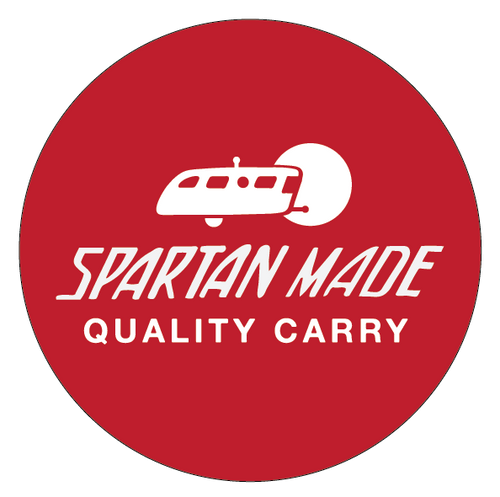FAQ
Transparency is at the heart of what we do at Spartan Carry. We love talking shop. If you don’t find your question here, submit one to us below, and help turn this FAQ into an Encyclopedia Spartanica.
Q: What makes Spartan Made sustainable?
A: Sustainability is a complex topic that we’re deeply committed to. First, we choose quality materials and over-engineer our items to last longer, so that they’ll stay out of the waste stream for longer. We produce in small batches to avoid wasteful overstocks. We also strive to incorporate zero-waste design as much as possible into our pattern-making. It’s a little like origami, starting with a rectangular piece of textile and seeing how it can be folded and sewn to create a 3-D shape. Most of our designs are based on zero or low waste patterns. We try to use as much of the material as we can, and donate the rest to re-use places (like Fabscrap in Philly). Truly greening the textile industry is incredibly hard, but we’re trying!
Q: Do you have a shop?
A: Our current workshop isn’t open to the public, unfortunately, but our brick and mortar dreams are deferred, not abandoned. When we outgrew the 125 square foot Spartan Manor (with 7 sewing machines it wasn’t hard to do!) we decided to get a dedicated workshop space. We didn’t shoot for a storefront, but that’s what we got, and we loved our hybrid workshop/store in Oneonta, NY. We moved to Philadelphia in September, 2022: come visit us at a local maker’s market.
Q: Why do your products cost so much?
A: Simple. We use the best materials we can find and charge a fair rate for labor. Our products are made in the USA, and they’re over-engineered to last longer. The better question is why is everything else so cheap (and cheaply made)? Fast fashion fills landfills and shareholder pockets but doesn’t fill worker bellies, and it doesn’t fill our lives with objects that invoke joy. We believe in buying less but better, and we hope you’ll join us in supporting American craft.
Q: Do you do custom work?
A: Generally, no. Custom jobs often require completely new patterns, and that’s incredibly time-consuming. Moreover, the product you get is likely to be a prototype. In a blog post some time we’ll explain the prototyping and testing process we use to get a design to a point we’re happy with it. Suffice to say the first iteration is usually not that! That being said, we sometimes consider special versions of existing products, so feel free to contact us.
Q: Won’t the natural white canvas get dirty?
A: Yep. We’ve had a natural canvas tote bag from a famous company for over thirty years and I don’t recall washing it. It’s got a great patina. See our Care & Repair for more tips on spot cleaning the natural canvas. We haven’t tried Scotch Guard because we don’t like chemicals we can’t spell.
Q: What’s better for the environment, cotton or nylon?
A: We use natural materials (cotton, canvas, linen) and synthetics (nylon, dyneema, X-PAC) and some of our items mix both. The only synthetic on our tote bags, for example, is the Spartan Made label (we’re working on that). The truth is that it’s not an easy determination to make. Leather clearly has issues, though it’s a byproduct of the meat industry and not a driver of it. We use vegetable tanned leather to minimize environmental impact. Water usage is a key part of both tanning and cotton cultivation, and especially the latter can be quite environmentally destructive. That said, a cotton and leather bag will biodegrade fully and safely, while we worry that nylon and other synthetics will slowly rub away into micro plastics that are bad news for everyone. And of course there’s the enormous environmental toll of the petro-industry, from global warming to spills to the cancer rates around refineries.
Q: Are your bags Vegan?
A: Our sport line made of synthetics is vegan. Our natural line is not, often using both beeswax and leather. However, our waxed canvas does not use petroleum products.
Q: Why don’t you use faux leather?
A: In most cases, that means a petroleum-derived product that doesn’t act, feel or look like real leather (so what’s the point?). There’s some really promising leather alternatives being developed from natural sources like fungus. Right now they’re hard to get, especially for small makers. Hoping some day to get to work with them!
To submit a question, visit Contact.
